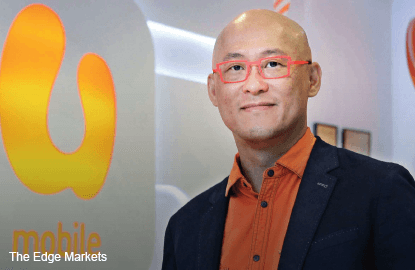
This article first appeared in The Edge Malaysia Weekly, on January 4 - January 10, 2016.
 THE long-awaited initial public offering (IPO) of U Mobile Sdn Bhd, the country’s youngest telecommunications operator, could take place within the next two to three years. This, however, can only happen if the loss-making company manages to break even within that time frame.
THE long-awaited initial public offering (IPO) of U Mobile Sdn Bhd, the country’s youngest telecommunications operator, could take place within the next two to three years. This, however, can only happen if the loss-making company manages to break even within that time frame.
Launched in 2007, U Mobile has made an impact on the market as its subscriber base grew from less than 50,000 to over four million in less than five years. Over the years, it has been seen as a serious challenger to the Big Three telcos — Maxis Bhd, DiGi.Com Bhd and Celcom Axiata Bhd.
According to CEO Wong Heang Tuck, his immediate target is to make U Mobile “IPO-able” by 2018, as the company is expected to become Ebitda (earnings before interest, taxes, depreciation and amortisation) positive by then.
“We are targeting Ebitda break-even and IPO in about two to three years. By then, we would have grown much bigger in size. Of course, if we do well, the plan will be accelerated,” he tells The Edge in an interview.
Wong was appointed CEO in April 2014. Since he joined the company as chief operating officer in 2013, U Mobile’s revenue and market growth have outperformed the industry average.
Previously, Wong was chief financial officer of WBL Corp Ltd, a Singapore-listed multinational conglomerate. He has more than two decades of experience in finance, business and corporate development.
U Mobile is, today, the fourth largest mobile operator in Malaysia, with a market share of close to 8%. Wong says it is aiming for a double-digit market share in the coming years, which should help it build its profit track record, or at least, break even.
“Ebitda positive is a key milestone for us before we do the IPO, because that will give investors confidence,” he says. However, he declines to reveal U Mobile’s Ebitda figures.
A quick check on the Companies Commission of Malaysia’s website shows that U Mobile’s net loss contracted to RM191.82 million in its financial year ended Dec 31, 2014 (FY2014) from RM363.24 million in FY2013. Revenue rose from RM919.17 million to RM1.26 billion.
U Mobile has allocated a capital expenditure (capex) of RM3 billion to RM4 billion for its five-year expansion plan, mainly to expand its third generation (3G) and fourth generation long-term evolution (4G LTE) network infrastructure by rolling out 5,000 new base stations to cover the whole country.
To date, it owns 3,200 network sites for 3G and 1,281 sites for 4G. It also has 1,880 network sites for 3G that are shared with Maxis.

“We are not going for a listing for the sake of going for a listing. Yes, our [current] shareholders are a source of funds, but eventually, we need multiple sources of funds,” he says.
He adds that the most efficient way to raise funds is through a combination of capital market, equity market and loan market. In order to tap these sources of funds, the best way is to go for a listing.
“A telco is like a utility firm. Investment in technology is a must; the day the telco stops investing is the day it dies,” he explains.
While it is still too early to tell how big the IPO will be, Wong acknowledges that the five-year capex plan will tap into the IPO funds. “Maybe 25% to 30% will be fresh funds coming from the equity market. Once we go for a listing, we can have a series of bond and loan [issuance].”
On U Mobile’s listing destination, he says the priority is Bursa Malaysia. However, he did not rule out the possibility of floating its shares on other stock exchanges, including Singapore and Jakarta, as well as a primary listing in Shanghai, China, and a secondary listing in Kuala Lumpur.
“If you look at the regional bourses today, Malaysia has the best valuation for telcos, be it Ebitda multiple or price-earnings ratio. But three years later, I wouldn’t know,” he says.
Currently, Straits Mobile Investments Pte Ltd, a unit of Singapore Technologies Telemedia, is the single largest shareholder of U Mobile with a 49% stake.
U Telemedia Sdn Bhd, a private investment by local tycoon Tan Sri Vincent Tan Chee Yioun, is the second largest shareholder with a 21.46% stake.
Tan, who is the chairman of U Mobile, also has a 6.2% direct stake in U Mobile as well as 2.01% equity interest via Berjaya Infrastructure Sdn Bhd.
It is worth noting that U Mobile on Dec 18 announced that Sultan of Johor Sultan Ibrahim Sultan Iskandar has acquired an additional 5% stake in the company, raising his holding to 15%. Sultan Ibrahim acquired his initial 10% stake in U Mobile in 2014.
Locally listed Magnum Bhd also has a 6.33% stake in U Mobile. Low-profile Thai-born tycoon Tan Sri Surin Upatkoon, who is the non-executive chairman of Magnum, also sits on the board of U Mobile as director.
Save by subscribing to us for your print and/or digital copy.
P/S: The Edge is also available on Apple's AppStore and Androids' Google Play.